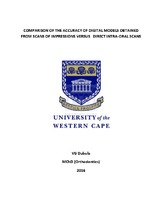Comparison of the accuracy of digital models obtained from scans of impressions versus direct intra-oral scans
Abstract
Measurements and a variety of analyses of dental casts are essential for precise diagnosis of an orthodontic case. Study models have long been an essential part of orthodontic diagnosis and treatment planning. Currently virtual computerized models are available to clinicians, supplemented by dedicated software for performing needed measurements (Zilberman et al, 2003). Digital impression methods are now available and intraoral digital scanning techniques make it possible to generate study models directly from the scanning of the dentition. The aim of this study was to compare measurements taken after scanning the dental impressions to the measurements obtained from using direct intraoral scanning of the dentition. Alginate impressions of the maxillary and mandibular dentitions were taken on 20 patients and these impressions were scanned using a 3 Shape R 700 TM scanner. Direct intraoral scans of both dentitions were then performed for the same patient. Ortho analyzer TM software was used to measure the mesiodistal widths of individual teeth, and the intercanine and intermolar on digital models of the scanned impressions and digital models obtained from direct intraoral scans of the maxillary and the mandibular dentitions. The results indicated that there were no statistically significant differences between mesiodistal widths, and intercanine and intermolar distances between the two techniques (p > 0.05). Because of the high level of accuracy of the virtual measurements compared to those of the scanned impressions, it can be concluded that direct intraoral scanning of the dentition can be used with confidence in the clinical situation to measure tooth sizes and inter-arch distances for orthodontic purposes. Orthodontists commonly use models for various areas in the practice, clinical research and medico-legal documentation (Marcel, 2001)

